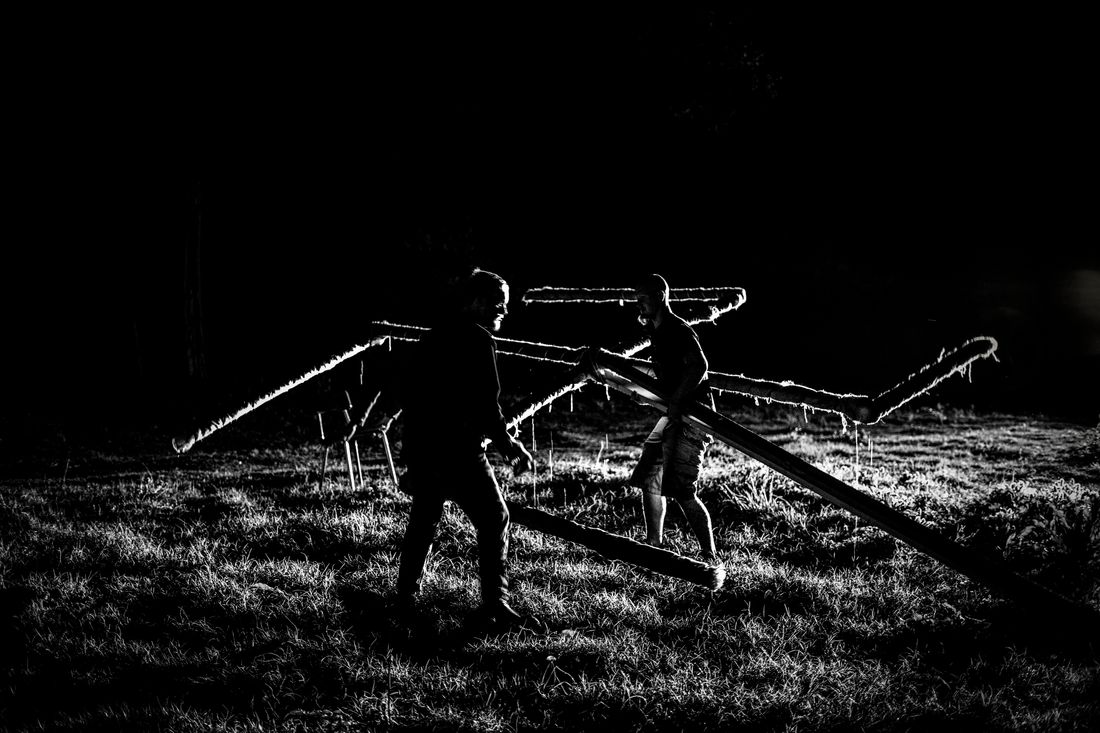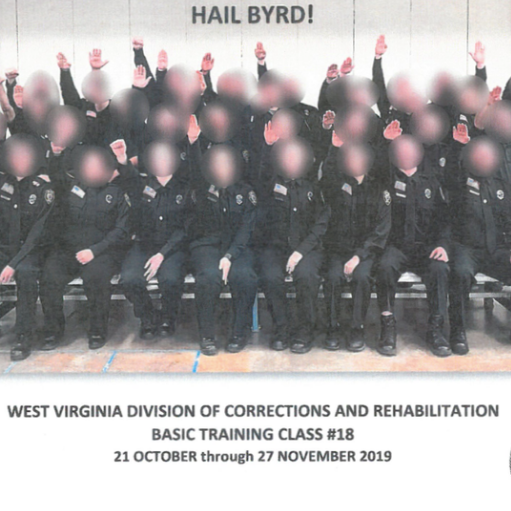According to Killedbypolice.net, at least 808 people have been killed by police so far
this year, outpacing last year’s deaths by 20 victims.... and they ALL GET
AWAY WITH IT!
"Police in
the United States are trained to
see the working class and poor as a
hostile
Entire West Virginia Correctional Officer Class Fired Following Investigation Into Nazi Salute Photo
RELATED
Operation Relentless Pursuit: Federal agents occupying a city near you
There is, we are told, “no money” for decent-paying jobs, schools or housing in the United States. Yet at a December 18 press conference, US Attorney General William Barr confirmed that there are always funds for what Friedrich Engels called the “special armed bodies” of the state.
As part of a new law-enforcement initiative, Barr announced that an additional $71 million in federal funds will be allocated to seven US cities ahead of the 2020 presidential election.
 A Secret Service agent stands guard. (Source: Wikipedia.org, Gabriel A. Silva)
A Secret Service agent stands guard. (Source: Wikipedia.org, Gabriel A. Silva)
“Operation Relentless Pursuit” will be led by the US Justice Department in close coordination with both political parties, local police departments and multiple federal agencies, including the Bureau of Alcohol, Tobacco, Firearms and Explosives (ATF), Immigration and Customs Enforcement (ICE), the Drug Enforcement Agency (DEA) and the Federal Bureau of Investigation (FBI).
The federal initiative will provide financial and logistical resources to enable closer collaboration and communication between federal agencies and their “local partners,” which include police departments, district attorneys and sheriffs. Money, equipment and federal agents will be deployed as part of a quasi-occupation of working class urban neighborhoods.
It is unclear how long the operation will last. In an interview with the Wisconsin Examiner, Kenneth Gales, a spokesman for the US Attorney’s Office for the Eastern District of Wisconsin, confirmed that “there is no time limit.”
At his press conference, Barr stated that the seven cities were chosen for their “high violent crime rates.” However, he noted that consideration was also given to the willingness of local agencies to cooperate with federal officials. At the same press conference, DEA Administrator Uttam Dhillon emphasized that the money will be used to target “drug traffickers, including cartels and street gangs [that] will stop at nothing to turn a profit.”
The seven cities are Albuquerque, New Mexico; Baltimore, Maryland; Cleveland, Ohio; Detroit, Michigan; Kansas City, Missouri; Memphis, Tennessee; and Milwaukee, Wisconsin. According to Barr, the funds will also be used to hire an additional 400 police officers.
FBI data released earlier this year shows that violent crimes decreased a further 3.9 percent in 2018, continuing a decades-long trend. Official figures indicate a 50 percent drop in violent crime since 1990.
Violent crimes include rape, assault, murder and robbery. The only statistic that showed an increase, for the sixth year in a row, was rape. However, this is most likely due to the FBI changing its definition of rape to include consent, as opposed to the former definition, which defined rape as forcible “carnal knowledge of a female.”
Despite the falling crime rate, US police departments have continued their deadly attacks. According to the Washington Post, 897 people have been killed by police departments so far this year. This may increase as more data is compiled, bringing the total of people killed by the police to more than 1,000 for the sixth year in a row.
The additional funding is being made available for policing while residents in every one of the targeted cities face deteriorating infrastructure, including lead-lined water pipes, school closings and a severe lack of affordable housing.
In Milwaukee, Democratic Mayor Tom Barrett has already allocated nearly half of the city’s available funds to the Milwaukee Police Department. The department currently has 1,804 officers, with an estimated 2020 budget of $298.3 million, approximately 47 percent of the entire city budget.
The only criticism from Wisconsin officials of the federal government’s plan to increase the police presence in Milwaukee came from LaKeshia Myers, a Democratic member of the State Assembly. Myers did not object to the increased police funding, but to the fact that it was limited to the city of Milwaukee. She expressed the desire to see federal agents deployed throughout state, telling the Examiner that she hoped “the radius [of the operation] is not just limited to the city of Milwaukee.”
In the southwest city of Albuquerque, out of the nearly $1.1 billion 2020 budget, over $205 million will be spent on the 1,043 officers in the Albuquerque Police Department. This includes $6 million for new vehicles and $3.7 million in “investments” in the newly created “gun intelligence center.”
While the police will have the latest ballistics technology through their new gun center, more than 1,500 people in Albuquerque will be homeless tonight. In a point-in-time survey conducted by the Albuquerque Journal, 1,524 sheltered and unsheltered homeless people were counted in the city this past January. City officials admit that this figure is most likely a drastic undercount.
The Democratic mayor of Detroit, Mike Duggan, also saw fit to increase funding for the Detroit Police Department in the 2020 budget by an additional $10 million, bringing the total to $331,162,000, or over 30 percent of the city’s $1.1 billion annual budget.
These cities show that no matter which political party is in power, massive resources are provided to the armed defenders of private property. Statistics compiled in 2016 from urban.org estimated that the US collectively spent more than $100 billion on policing and an additional $80 billion on incarceration.
Overall state and local spending on policing and incarceration has skyrocketed in the US over the last 25 years. From 1997 to 2016, state and local spending on police and incarceration jumped from $59 billion to $187 billion, a 216 percent increase.


When Dylann Storm Roof walked into the Emanuel African Methodist Episcopal Church in Charleston, South Carolina, he joined the Bible-study class before gunning down nine African-Americans as they prayed.
Roof still communicates with his admirers on the outside. In jail, he began exchanging letters with a man in Arkansas named Billy Roper. A former schoolteacher and the son and grandson of Klansmen, Roper leads the Shield Wall Network, a group of several dozen white nationalists who organize rallies and conferences — often collaborating with neighboring hate groups — with the goal of building a white ethno-state. “I have a lot of empathy for him. I’m 47, and he’s young enough to be my son,” Roper said of Roof when interviewed recently for this project. “These millennials and now, I guess, Gen-Zers that are coming up, they are not stupid about the demographic trends and what they portend for the future. That angst, that anxiety that plagues them, drives them to do rash things — whether it’s that rash or not — I can empathize with.” I would humbly suggest we believe that Roper is being sincere, and that he speaks for many.
Roper and Roof are only two of those affiliated with the 148 white-nationalist hate groups in this country. Though it is impossible to calculate their exact membership numbers (as individual groups either conceal or inflate them), their violence is indisputable. White supremacists were responsible for the deaths of at least 39 people in 2018 alone. And the activity has not slowed this year: not in January, as neo-Nazis plastered flyers outside newspaper offices and homes in Washington State and the Carolinas and an army veteran pleaded guilty to killing a black man in New York to “ignite a racial war”; in February, as Vermont synagogues and LGBT centers were vandalized and a self-described white-nationalist Coast Guard lieutenant was arrested for plotting a domestic terror attack; in March, as WELCOME TO GERMANY and GAS THE JEWS were spray-painted outside Oklahoma City Democratic Party and Chickasaw Nation offices and, on the Upper East Side, classmates handed their school’s only black ninth-grader a note reading “n—–s don’t have rights”; in April, as a shooting at a synagogue left one dead and three injured and FBI Director Christopher Wray called white supremacy a “persistent, pervasive” threat to the country; in May, as swastikas fell from the sky — on flyers dropped by drones outside an Ariana Grande concert — and were scrawled on public spaces in at least three states; in June, as far-right groups rallied in Portland, Oregon, for the first time that summer; in July, as a man promoted a white-power manifesto on Instagram before killing three and wounding 17 others at the Gilroy Garlic Festival in California; in August, as another angry young man — this one 1,000 miles away in El Paso, Texas — posted an anti-immigrant manifesto online then committed this year’s most deadly mass shooting, killing 22 and injuring 24 at a Walmart; in September, as the Department of Homeland Security added white-supremacist extremism to its list of priority threats, the same month a swastika appeared on its walls; in October, as swastikas also appeared on Cape Cod and invitations to a white-supremacist gathering were mailed to Maine residents; in November, as a white-supremacist group filmed a video outside Mississippi’s Emmett Till Memorial; nor this month, as students flashed possible white-power signs at an Army-Navy football game.
The photojournalist Mark Peterson has documented this year, traveling the country to surface the extent of the activity and catalogue the most dangerous ideologies. His quotidian look at contemporary American Confederacy and white nationalism shows us our neighbors in other robes. The people portrayed are living among us in every region of the country, in our workplaces, in our government, on social media, and, for some, in our homes. Their culture is made up of both public rallies and private rituals. We see their homes and their streets and their schools, and that these are also our streets and our schools and our neighbors. “These pictures weren’t just taken in the South,” says Peterson, who covers the right wing and began documenting the rise of white nationalism after the 2016 election. “They were taken in New York, in New Jersey, in California, in Portland. The idea of quarantining it or ignoring it: That didn’t work in the past when they tried to do that, and it won’t now.”
The barrage of daily headlines makes it easy to see this year’s incidents as isolated, as white noise in the background of our relentless political moment. But as disturbing as they are, these images portray the American story. It is our inheritance, institutionalized since the Civil War by a government that only recently, and tentatively, began to address domestic terrorism for what it is. White nationalism, legitimized by our president’s support of “very fine people,” has flourished in part because of this refusal to look it squarely in its face and acknowledge it as homegrown. Without a full accounting of the reality, there can be no remedy. To look away is a form of collaboration. —Claudia Rankine

No comments:
Post a Comment